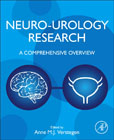
Neuro-Urology Research: A Comprehensive Overview describes the current status of the neuro-urology field, discusses potential future directions and explains the latest neuroscience tools that can be used in neuro-urology research. The first section provides an overview of the circuit-based interrogation of subcortical and spinal networks involved in bladder filling and voiding. The second section discusses the translational potential of research for patients including specific chapters on the sensation of bladder stretch, bladder pain, the effects of hormones and the potential results of neurodegeneration on bladder function. The third section compares traditional and current studies determining the need for addressing or readdressing principles or adjusting dogma. Section four introduces techniques including optogenetic manipulation and calcium imaging of neural activity, and on how these methods can be applied to neuro-urology research. The fifth and final section proposes studies in directions that have remained underexplored or otherwise controversial. Perfect for all currently researching neuro-urology, this detailed understanding of the cellular and synaptic circuits that control bladder filling and voiding and of the circuitry regulating bladder function, has the potential to inform the development of newer therapeutics for treating LUTS. Conveys the importance of a deeper understanding of the basis of the neural control of bladder function to bridge gap in understanding of the neuro-urology research fieldStresses and highlights the importance of fundamental research before scientific results can be applied to clinical settingsIncludes cutting edge neuroscience techniques like (wireless/ radiofrequency) optogenetic manipulation of cell activity, and gene profilingSummarizes the outcomes of the latest research and overview of how new findings compare with more traditional studies and clear explanations of how neuro-urology research may be applicable to treating patients with LUTS INDICE: Research on neural circuits 1. Neural networks controlling bladder function Translational effects of neuro-urology research on clinical practice 2. How can treatment of LUTS caused by altered detrusor activity, benefit from basic research 3. Bladder pain signaling/pathway 4. Patient population-specific LUTS 5. Hormonal effects on voiding Neuroscience in urology research 6. Neuro-urology research from the 1920s to the early 2000s compared to neuro-urology research in the present 7. Pontine micturition center neuron subpopulations 8. Voluntary versus reflex control 9. Urology as readout for neuroscience research Cutting edge/state of the art neuroscience tools applied to neuro-urology 10. Optogenetics, Neurolux system/wireless, ChR2-mouse lines and their application in neuro-urology research 11. Fiber photometry, imaging of neural activity, GCaMP6-mouse lines, and their application in neuro-urology research 12. Transcriptome profiling; comprehensively cataloging neuron subpopulations, their transcriptional markers, and the application in neuro-urology research The future for the neuro-urology field 13. Midbrain periaqueductal gray (PAG), the bladder control command center 14. Neural control of continence
- ISBN: 978-0-12-822455-7
- Editorial: Academic Press
- Encuadernacion: Rústica
- Páginas: 308
- Fecha Publicación: 01/06/2021
- Nº Volúmenes: 1
- Idioma: Inglés
